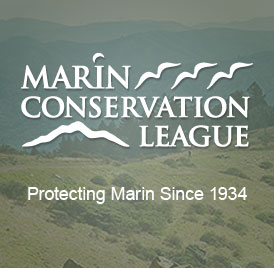| Marin Conservation League | 175 N. Redwood Dr., Ste. 135 | San Rafael CA 94903 | Tel 415.485.6257 | Fax 415.485.6259 Email Us. |
 |
National Park Service Air Tour Management Plan
Two operators – San Francisco Helicopter Tours and San Francisco Seaplane Tours – currently offer commercial sight-seeing air tours over GGNRA, including Alcatraz and Muir Woods, as well as Angel Island and the Coast. (A “commercial air tour operation” is any flight for sightseeing over a national park, including a half-mile buffer zone, below 5,000 feet above ground level.) In response to growing controversy over low-flying aircraft flights that were both intrusive and unsafe over national parks, Congress passed The National Parks Air Tour Management Act of 2000 (NPATMA), directing Federal Aviation Administration (FAA) and National Park Service (NPS) to work together to develop Air Tour Management Plans (ATMPs) for parks where air tours were occurring. The objective was to mitigate or prevent adverse impacts of air tour operations on natural and cultural resources, visitor experiences, and tribal lands within or abutting national parks like GGNRA and the Seashore. FAA has sole authority to control airspace and ensure air safety, and the NPS has the responsibility to conserve the scenery, visitor experience, and natural resources in National Parks for future generations. After more than 10 years, no ATMP for any national park had been completed.As a consequence, neither the safety of air tour operations, nor the opportunity for park visitors to experience the unimpaired sounds of nature, has improved.
In the absence of an approved management plan, local tours are currently managed under FAA “interim operating authority” (IOA), which permits the two tour operators to fly a maximum of 2,190 Seaplane Tours and 2,900 Helicopter Tours per year, based on unverified records of the companies’ flights during the 12 months preceding enactment of the NPATMA in 2000. No air tours are operating over the Seashore at this time, although they are actually permitted. That could change with an ATMP.
Threat to Wildlife. Of paramount concern to MCL and other environmental organizations is the potential disturbance to the sensitive wildlife in the parks from low-flying aircraft such as helicopters. GGNRA is home to one of the largest concentrations of rare, threatened and endangered species in the national park system, and, along with the Seashore, is part of the United Nations-designated Golden Gate International Biosphere Reserve. Offshore, the Gulf of the Farallones National Marine Sanctuary supports abundant marine life including gray whales, elephant seals, harbor seals, and others. Muir Woods provides a special forest habitat for spotted owls, and Redwood Creek supports the endangered coho salmon. Pt. Reyes National Seashore is not currently subject to air tour over flights, but is home to over 65 species of mammals, 85 species of fish, 29 species of reptiles and amphibians, and breeding habitat for 130 species of birds. Over 480 species of birds, nearly half the bird species of North America, have been spotted in the Seashore. Elephant seals breed on land at the Seashore and many other species of marine mammals feed and migrate in the waters just offshore that are within the Seashore. For this reason, MCL believes it would be unacceptable to continue air tours over Muir Woods or initiate tours over any parts of the Seashore.
Disruption of experience on the ground
There are other reasons to restrict air tours. Muir Woods offers particular value for visitors on the ground as a quiet and primeval sanctuary, and noise management is central to ensuring that visitor experience. Natural sounds at the Seashore include ocean waves, bird and other animal calls, flowing water, and wind, as well as noise from rural activities – such as farm equipment and domestic animals. The distribution of trails throughout the park allows visitors to escape from human activities into wilderness; this is a treasured opportunity enjoyed by the millions of visitors. Low aircraft would destroy this experience on the ground. In addition, one of the existing air tour flight tracks currently goes over residential neighborhoods in and nearby Tamalpais Valley in Southern Marin. Residents should not have to endure erratic and disruptive noise of helicopters en route daily to various parts of the national parks.
Alternatives. The Environmental Assessment is required to consider a “No Project” Alternative. This would be a continuation of the present condition – that is, air tour companies operating under the current IOA. The companies have been permitted a total of 5,190 flights per year but are not currently operating at this level, or operating at all over the Seashore. Unless contested, the FAA could take the currently permitted operations and use them as the baseline for setting operation levels for the ATMPs. Because the IOA was developed without any environmental analysis, this exaggerated baseline could be permitted in spite of significant impacts.
The EA will examine two other alternatives, including (1) prohibiting commercial air tour operations over and within ½-mile outside the boundary of either national park; and/or (2) establishing conditions for the conduct of air tour operations, such as limiting specific destinations and routes, limiting the maximum number of flights per unit of time, maximum and minimum altitudes, time of day restrictions, restrictions for particular events, and mitigation of noise, visual, or other impacts. GGNRA also includes Fort Point National Historic Site and the San Francisco Maritime National Historical Park, an independently managed national park unit adjacent to GGNRA. These and other sites within GGNRA that lie in urban areas may be less susceptible to aircraft noise than the remote parklands in Marin. These are areas that should be assessed carefully to avoid unnecessary disturbance.
MCL agrees with the National Parks Conservation Association that “the opportunity to listen to unobstructed natural sounds is an increasingly rare experience in America. We must ensure our national parks provide the special experience they were intended to provide, which is why the implementation of the National Parks Air Tour Management Act is so important.”
2011 Documents and Correspondence:




